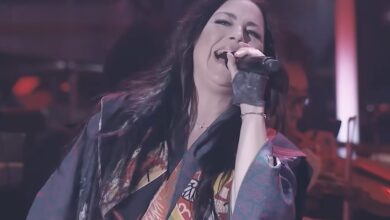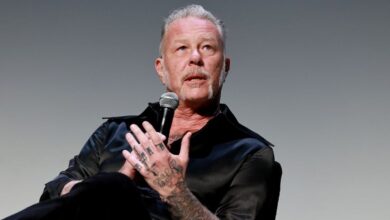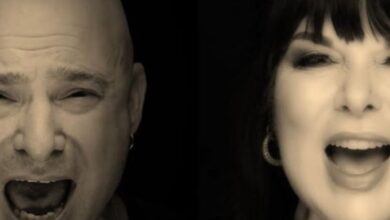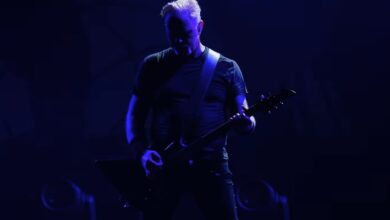Ozzy and Metallica’s “Paranoid” Returns in Stunning Clarity After His Farewell
In the fall of 2009, Madison Square Garden became the epicenter of heavy metal history. The 25th Anniversary Rock & Roll Hall of Fame Concerts were already a big deal—but what unfolded on that stage was something no one saw coming. Metallica, the fiercest torchbearers of modern metal, welcomed Ozzy Osbourne to share the spotlight for two of Black Sabbath’s most iconic songs: “Iron Man” and “Paranoid.” It wasn’t just a concert—it was time travel with distortion pedals.
The atmosphere was supercharged before Ozzy even walked out. Metallica had already crushed a handful of their own songs when the lights dimmed and a silhouette shuffled into view. That silhouette was Ozzy. As the crowd erupted, it felt like a storm had landed inside the Garden. Dressed in black, arms outstretched like a prophet of chaos, he greeted the roar with a grin that said, “Let’s go.” And go they did.
“Iron Man” started with that monstrous, unmistakable riff. It was like hearing the voice of the Earth crack open—Tony Iommi’s original guitar line now being handled by James Hetfield and Kirk Hammett with both reverence and raw power. Ozzy’s voice sliced through the wall of sound, raspy but defiant. It wasn’t the voice of a young man—it was the voice of a legend who had lived every damn word.
What made the performance special wasn’t just who was on stage—it was how tight the chemistry was. Metallica didn’t just back Ozzy, they powered him forward. Hetfield, often the dominant force onstage, shifted into supportive rhythm mode, giving Ozzy all the space he needed. Lars Ulrich’s drumming was fierce but restrained—no showboating, just pure Sabbath pulse.
Then came “Paranoid,” and the whole building ignited. From the first frantic guitar stabs to the bouncing rhythm section, it was clear this would be no nostalgic limp-along. Ozzy turned the clock back thirty years, leaping (almost literally) into the chaos. His grin widened. Kirk Hammett’s solo was searing, bridging classic blues-based leads with his own flair. Everyone on stage looked like they were having the time of their lives.
But there was weight behind the smiles. This wasn’t just play—it was tribute. Metallica had inducted Black Sabbath into the Hall of Fame just a few years earlier, calling them the bedrock of everything they’d built. Now, they were living that respect, riff for riff, scream for scream, showing how Sabbath’s DNA had shaped their own brutal rise through the decades.
The show itself had been curated to tell stories through sound. That night featured pairings that spanned generations, but none hit harder than this. Sabbath and Metallica were more than acts—they were movements. Watching them play together didn’t feel like crossing paths. It felt like stars aligning. One constellation was being drawn by another.
For Ozzy, the night was both a victory lap and a jolt of fire. He wasn’t there to look back with sentimentality—he was there to command. You could see it in how he raised his arms, how he tilted his head back and unleashed those howls. There was power in it. Even as time had etched lines into his face, his spirit hadn’t dulled a bit.
The crowd’s reaction told the story as much as the music did. Thousands were caught between awe and euphoria. Younger fans, some of whom may have only known Ozzy as “that guy from the TV show,” got a visceral taste of the madman in his element. And longtime Sabbath disciples had their holy moment—Metallica, the mighty heirs, playing Sabbath’s gospel with the man who started it all.
There’s something poetic about the way this performance mirrors Ozzy’s final acts. In 2025, at his farewell concert in Birmingham, Ozzy once again sang “Iron Man” and “Paranoid”—this time seated, but no less mighty. That moment echoed back to Madison Square Garden, where he last stood as part of something larger than legend—legacy.
Metallica, too, seemed changed by it. Their own sets in the years following leaned harder into Sabbath-esque heaviness. You could feel the imprint of that night in their tone, in their choices, in their reverence for origin. Playing with Ozzy wasn’t a gimmick—it was a reset button. It reminded everyone what metal was meant to be: dark, loud, and unstoppable.
This wasn’t the first time they shared that reverence. Back in 2006, when Metallica inducted Black Sabbath, Hetfield called them “the fathers of all things heavy.” They even played “Iron Man” and “Hole in the Sky” in tribute that night. So when they reunited in 2009, it wasn’t just a surprise—it was destiny closing the circle.
The whole thing was recorded and released in high definition, giving fans a front-row seat forever. Those who missed the magic in person could relive it on DVD, CD, or streaming, with every ounce of sweat and volume preserved. You can almost smell the amps overheating. And Ozzy’s voice—gritty, glorious—rings out like a war horn through time.
Looking back, this was a peak—one of those “were you there?” moments etched in the minds of fans forever. Two titans, two different eras, one language: metal. They didn’t just play songs. They reminded the world that behind every headbang and stage dive, there’s blood, sweat, and a legacy forged in steel. That night, steel met fire. And fire won.





